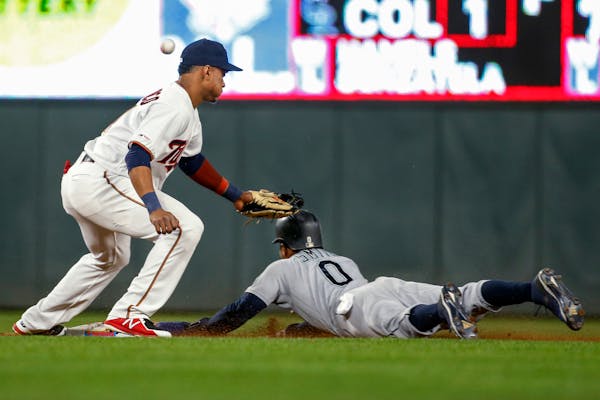The Twins own the highest-scoring offense in the American League, and there's no mystery about why. They hit home runs — lots and lots of them. But do they ever worry that they're becoming too reliant on hitting the ball out of the park?
"You could, if you were selling out just to hit home runs. It's more about how you're getting them," said hitting coach James Rowson, who has watched his team average nearly two home runs a game, a mark never reached in MLB history over a full season. "What's your approach? What's your mind-set? We talk about that every day."
Entering Wednesday's game, the Twins had hit 127 home runs in 65 games, accounting for 202 of their 388 runs — an astonishing 52.1% of their offense. Yes, home runs have become more plentiful as teams have applied statistical evaluation to the problem of how to hit more of them, but this is an unprecedented level of reliance on long balls.
Last year, the Twins scored 35.4% of their runs on homers, and it was 39.6% during their wild-card season of 2017. A decade ago, the 2009 Twins accounted for just 33.7% of their offense with home runs, and the average of the team's 58 seasons is only 25%.
Even their Harmon Killebrew-led 1963 and 1964 teams, which slugged their way to the franchise record of 225 and then 221 home runs, scored 45.1 and 46.5% of their runs on homers.
It's not just the Twins, of course. Home runs accounted for more than 40% of runs scored for the first time last season, and it's up to 44.7% this year.
A home run-reliant offense figures to be streaky, Rowson said, but he doesn't think these Twins will be susceptible.
The Twins lead the AL in batting average and are second in on-base percentage, he pointed out. "Our mind-set is to put good swings on pitches and try to hit the ball hard consistently," Rowson said. "We focus on the approach, not the result. If that's the method, it's maintainable."
Nice framing job
When Trevor May's 3-2 pitch to Edwin Encarnacion on Tuesday was in flight, Jason Castro was concentrating on one thing: Don't let the fastball's 96-mph velocity shove your glove any farther out of the strike zone.
"That's the biggest thing for a borderline pitch — you have to counteract any movement that the pitch imparts into your glove," Castro said. Catchers rarely steal a strike by moving their glove into a better spot, but by staying as motionless as possible, the catcher can make a pitch appear better than it actually is. "Basically, I'm trying to absorb that velocity without a recoil, so the ball doesn't carry out of the zone and become a non-strike."
Perhaps that pitch framing convinced home plate umpire Mike Estabrook to call Encarnacion out. Or perhaps, as May himself asserted, the pitch was a strike because Estabrook had been calling it a strike already that night. Either way, the strike-three call — on a pitch that MLB's radar judged to be a couple of inches outside — turned a potential bases-loaded, no-out emergency into a two-on, one-out challenge that May handled without a run scoring, preserving the Twins' 6-5 victory.
"It was right there. [Castro] caught it really well. It was over the plate," May said. "Usually [hitters are] looking for something up. He was not expecting something down and away."
Castro credited May's command, and Estabrook's pattern on outside pitches, for the huge out.
Astudillo stays hot
Willians Astudillo homered for the third time in four games since being sent to Class AAA Rochester last weekend. The rookie catcher also flew out three times in the Red Wings' 3-2 loss to Columbus, dropping his Triple-A average to .563 (9-for-16).
